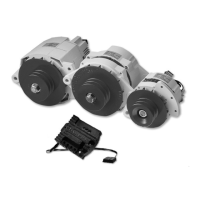MAINTENANCE
20 June 2007 / Alpha alternator - Alpha Pro regulator / EN
6 MAINTENANCE
During maintenance of the Alpha Alternator, Alpha
Pro regulator and/or the engine, the Safety
Guidelines & Measures are applicable at all times.
See section 2 of this manual.
See below for preventive maintenance procedures
that will contribute to many years of trouble free
operation of the Alpha alternator and the Alpha Pro
regulator.
6.1 ELECTRICAL CONNECTIONS
Check the wiring at least every six months. Defects
such as loose connections, corroded connections,
burned cables etc. must be corrected immediately.
6.2 CLEANING OF THE ALTERNATOR
The interval for cleaning of the alternator strongly
depends on environmental conditions, but should be
at least every six months.
Insure that all alternator surfaces are clean to the
point that they do not have a buildup of dirt, grease
or dust. Air flow passages must also be clear so that
air can easily pass through the unit.
The alternator’s bearings are greased for life and not
regreasable.
6.3 MOUNTING OF THE ALTERNATOR
Check the mounting of the alternator after the first 50
running hours. Then every 150 running hours or at
least every year, whatever comes first.
Make sure that the alternator is securely mounted to
its applicable brackets. The brackets, in turn, need to
be bolted securely to the engine. Poorly or loosely
mountings may lead to damaging vibration as well
as diminished belt drive performance
6.4 TENSION AND CONDITION OF V-BELTS.
Loose belts will slip on the pulley, fail to turn the
alternator’s rotor and finally overheat the alternator.
The tension of new V-belts must be checked after
the first 50 running hours. Then every 150 running
hours or at least every year, whatever comes first.
Before adjusting the V-belt tension, inspect it for
glazing, cracks, or dryness. A worn or damaged V-
belt should be replaced.
If the V-belt is in satisfactory condition, check belt
tension with cricket belt tension gauge. Refer to
manufacturer's specifications for proper belt tension.
If necessary use proper tensioning gauge for your
application. Then adjust the tension accordingly.
If you replace a worn or damaged V-belt, the new
belt should be checked for proper tension as well. A
new belt loses 60% of its tension in the first few
hours of operation. After a new V-belt is installed,
run the engine with full load connected to the
alternator for approximately 15 minutes. Then check
the belt tension again and adjust it if necessary.

